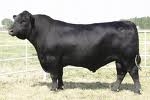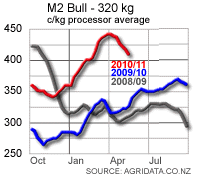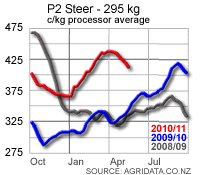
Much of the demand for beef in the US is driven by the barbeque season and traditional holidays that allow consumers to enjoy this way of eating. After a slow wet spring, things have warmed up and demand is picking up again. Economic factors also influence, and the price of oil affects the household budget and can determine how much is left over for the higher priced cuts of beef.
NZ's beef prospects and prices are heavily influenced by what happens in the US, with most of our manufacturing beef being consumed there. Our prime beef has many more outlets than that country alone, but US's exporting power can influences our returns.
Prices have dropped 6-7% in the last 7 weeks but maybe this demand is being rekindled in the US, to restart the resurgence of traditional winter pricing in export schedules.


Demand for beef has, at last, seen a seasonal pick-up ahead of the traditional start date for the US barbecue season, although analysts expressed doubts about the longevity of the rebound, and its impact on cattle futures reports Agrimoney. Protein giant Tyson Foods said that sales of beef, chicken and pork had improved over the past two weeks, helped by warmer temperatures. "We are happy with the improvement in demand we've seen following a cold, wet April," Donnie Smith, the Tyson chief executive, told investors.
"Demand feels pretty good for two weeks after Easter," he said, while adding that it was "not hardly where we wanted it to be two weeks before Memorial Day". The US Memorial Day holiday, which this year falls on May 30, is typically viewed as the start of the barbecue season, and a period of higher demand for grilling cuts of meat. The comments followed official data showing a steep rise in wholesale US beef prices on Monday, notably for the higher-quality choice cuts, which rose by an average of $2.73 per hundredweight to $177.52 per per hundredweight. "The packers are now buying for the Memorial Day holiday."
Nonetheless, prices for choice beef remain nearly $10 a hundredweight lower than a month ago, and demand could yet soften again if fragile consumer demand is damaged again, US Department of Agriculture analyst Rachel Johnson said."If fuel prices increase much above current levels, household budgets are likely to be re-evaluated," she said. "Demand for high-priced meat cuts could suffer as a result."
And US Commodities said that, with beef supplies set to be boosted over the summer as a knock-on of higher placements of animals on feedlots, it "remains negative throughout the summer" on live cattle prices. Live cattle futures extended their slide on Tuesday, with Chicago's near-term June lot falling Tyson also highlighted in its comments to the BMO Farm to Market conference support from strong US meat exports which, for beef, soared 32% in the first quarter of the year, official data show.
US exports to Japan and Hong Kong rose more than 60% year on year during the quarter, with shipments soaring 194% to South Korea, whose own livestock industry has been devastated by foot-and-mouth disease. Ms Johnson forecast that the rise in shipments would slow to 11% in the second quarter, and turn negative in the last three months of 2011, as supplies tighten again. In Chicago, live cattle for June stood 1.2% lower at 107.025 cents a pound, down 13% from the record high for a spot contract of 122.875 cents a pound reached early last month.
We welcome your comments below. If you are not already registered, please register to comment.
Remember we welcome robust, respectful and insightful debate. We don't welcome abusive or defamatory comments and will de-register those repeatedly making such comments. Our current comment policy is here.